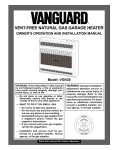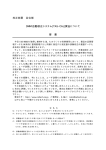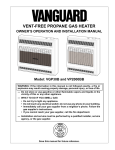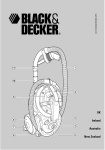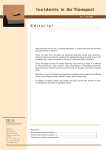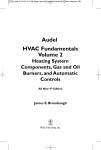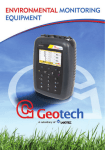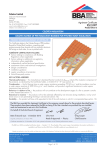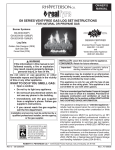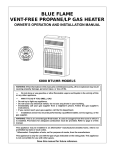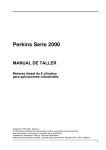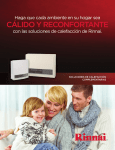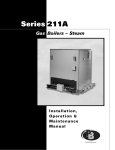Download VF Ceramic Heat Service Manual
Transcript
SERVICE MANUAL VENT-FREE GAS HEATERS VANGUARD FRONT GRH/PV 005 CERAMIC PLAQUE MODELS FOR YOUR SAFETY WARNING: Improper installation, ad- Do not store or use gasoline or other flammable vapors and liquids in the vicinity of this or any other appliance. justment, alteration, service or maintenance can cause injury or property damage. Refer to this manual for correct installation and operational procedures. For assistance or additional information consult a qualified installer, service agency or the gas supplier. M ERICA N SS N A O C IA T IO CE RTIFIED Save this manual for future reference. Y STANDARD ET S AF N ATI ONAL ITH S W A • Do not try to light any appliance. • Do not touch any electrical switch; do not use any phone in your building. • Immediately call your gas supplier from a neighbor’s phone. Follow the gas supplier’s instructions. • If you cannot reach your gas supplier, call the fire department. COMPL IES IGN ES D FOR YOUR SAFETY WHAT TO DO IF YOU SMELL GAS G 009 V E N T - F R E E TABLE OF G A S H E A T E R S E R V I C E M A N U A L Section 1 - Safety Information Safety Requirements .............................................................................................. 3 Warnings ................................................................................................................. 3 CONTENTS Section 2 - Introduction Technical Service Department ............................................................................... 4 Product Features .................................................................................................... 4 Accessories ............................................................................................................ 4 Section 3 - General Operation and Component Descriptions General Operation .................................................................................................. 5 Burner Assembly .................................................................................................... 5 Ignition System ....................................................................................................... 5 Control Valve .......................................................................................................... 6 Gas Regulator ........................................................................................................ 6 Oxygen Depletion System ...................................................................................... 6 Section 4 - Tools and Equipment ................................................................................. 7 Section 5 - Installation Gas Type ................................................................................................................ 8 Location: Safety Precautions .................................................................................. 8 Gas Supply Installation ........................................................................................... 9 Propane Installation ................................................................................................ 10 External Regulators ................................................................................................ 10 Section 6 - Test Procedures Testing Gas Supply Line Connections ................................................................... 11 Testing Heater Gas Connections ........................................................................... 11 Correcting Leaks .................................................................................................... 11 Testing Control Valve and Thermocouple .............................................................. 12 Section 7 - Specifications ............................................................................................. 13 Section 8 - Troubleshooting Ignition Problems No Spark ................................................................................................................. 14 Ignitor Sparks, But Pilot Will Not Light .................................................................... 15 Pilot Lights, But Will Not Stay Lit ............................................................................ 16,17 Main Burner Does Not Light (pilot stays lit) ........................................................... 18 Delayed Ignition Of Main Burner ............................................................................ 18 Combustion Problems Backfiring During Operation ................................................................................... 19 Smoke or Unwanted Odors .................................................................................... 19 Gas Odor ................................................................................................................ 19 Service Information ...................................................................................................... Back Page 2 V E N T - F R E E SECTION 1 G A S H E A T E R S E R V I C E M A N U A L SAFETY INFORMATION Safety Requirements This service manual is intended for use by individuals with adequate electrical and mechanical skills. Attempts to repair this heater by WARNINGS ! WARNING ICON individuals without those skills can result in personal injury as well as property damage. G 001 IMPORTANT: Read the Owner’s Manual carefully and completely before trying to assemble, operate, or service this heater. Improper use of this heater can cause serious injury or death from fire, explosion, electrical shock, electrocution, and carbon monoxide poisoning. ! DANGER WARNING ICON G 001 Carbon monoxide poisoning may lead to death! Early signs of carbon monoxide poisoning resemble the flu, with headaches, dizziness, and/or nausea. If you have these signs, the heater may not be working properly. Get fresh air at once! Have heater serviced. Some people such as pregnant women, persons with heart or lung disease, persons with anemia, those under the influence of alcohol, and those at high altitudes are more affected by carbon monoxide than others. Make certain you read and understand all Warnings. Keep the Owner’s Manual for reference. It is your guide to safe and proper operation of this heater. 1. Use only propane gas for models designated as propane. 2. Use only natural gas for models designated as natural. 3. If using propane model, do not place propane supply tank inside any structure. The propane supply tank must be located outdoors. 4. If you smell gas • Shut off gas supply. • Do not try to light any appliance. • Do not touch any electrical switch; do not use any phone in your building. • Immediately call your gas supplier from a neighbor’s phone. Follow the gas supplier’s instructions. • If you cannot reach your gas supplier, call the fire department. 5. Never install the heater • in sleeping quarters, a mobile home, or a recreational vehicle • where curtains, furniture, clothing, or other flammable objects are less than 36 inches from the front, top, or sides of the heater • as a fireplace insert • in high traffic areas • in windy or drafty areas 6. Always run heater at LOW, THERMOSTAT/MEDIUM, or HIGH locked positions. Never set control knob between locked positions. Poor combustion and higher levels of carbon monoxide may result. 7. Open window to admit fresh, outside air when using heater. Open window one (1) or two (2) inches. When used without fresh, outside air, heater may give off carbon monoxide gas. 8. Never run heater in small, closed room. Open door into next room to help ventilate. 9. If heater shuts off, do not relight until you provide fresh, outside air. If heater keeps shutting off, have it serviced. 10. Do not run heater • where flammable liquids or vapors are used or stored • under dusty conditions 11. Never place any objects on the heater. 12. Surface of heater becomes very hot when running heater. Keep children and adults away from hot surface. Heater will remain hot for a time after shutdown. Allow surface to cool before touching. 13. Make sure grill guard is in place before running heater. 14. Do not alter heater or its controls. Any change may create a safety hazard. 15. Make sure heater is turned off, unplugged, and cool before servicing. 3 V E N T - F R E E SECTION 2 G A S H E A T E R S E R V I C E M A N U A L INTRODUCTION Technical Service Department The Technical Service Department, located in Bowling Green, Kentucky, is committed to assisting our Authorized Service Centers and Dealers to provide prompt, efficient service. If you need assistance or have questions about servicing problems, please call DESA International’s Technical Service Department at 1-800-3235190. NOTE: This number is ONLY for technical service assistance and CANNOT be used for ordering parts, billing questions, order status, etc. For sales department and parts ordering, call 1-502781-9600. Product Features The ceramic plaque heaters covered by this service manual have many features that assure customer satisfaction and comfort. • Infra-red Heat: The glowing ceramic burner plaques give off infra-red radiant light which travels through the air and heats nearby objects. outage, the heater can be operated manually on high or low. • Piezo Electric Ignition: The heater can be started and operated without matches or other external means. The pilot is ignited by a spark created from the piezo ignitor when the control knob is depressed and turned to the “PILOT” position. • Variable Heat Output: The non-thermostat heaters can be adjusted to one of three alternative heat settings to provide user comfort. The thermostat heaters can be adjusted to the desired heat setting to permit economical use. In the event of a power • Oxygen Depletion System: The heater is designed to shut off if the oxygen level in the room falls to an unacceptable level. Accessories The following accessories are available from DESA International: 1. Fan Kit GA2100A. The fan accessory provides better heat distribution in the room. 2. Floor Mounting Stand GA4000 (3-plaque models) and GA4010 (5-plaque models). The floor stand allows the heater to be installed away from a wall. OPTIONAL FLOOR MOUNT-GRH FAN ACCESSORY-GRH Figure 1. Optional Fan Kit Figure 2. Optional Floor Mounting Stand For accessories, contact authorized dealers of this product. If they are unable to supply accessory parts, call DESA International at 1-502-781-9600. 4 A 005 A 007 V E N T - F R E E SECTION 3 G A S H E A T E R S E R V I C E M A N U A L GENERAL OPERATION AND COMPONENT DESCRIPTIONS General Operation NOTE: See Owner’s Manual for operating procedure. “PILOT” position so that the heater is ready to use. The heater is operated by the control knob located on the top of the heater. Be sure that the service supply valve is open and that the manual shut-off valve (Figure 8, page 9) is fully open. Depressing the control knob and turning it to the “PILOT” position will direct gas to the pilot and provide a spark to light the pilot. The control knob must be held down (at least 10 seconds) until the thermocouple is heated enough to hold the valve open. Once the pilot flame is established, the control knob can be released and turned to any of the operating position settings. The control knob can also be left in the Turning the control knob operates the control valve and directs the flow of gas to the pilot and the burner plaques. The gas is mixed with air and is injected into the burner chambers through tubes in the bottom of the burner. The air/gas mixture burns on the surface of the ceramic burner plaques, causing the ceramic plaques to glow with a radiant orange color. With proper care and servicing, the heater should give many years of satisfactory use to the customer. Be sure to inspect and service the heater at least annually. Burner Assembly The burner assembly is constructed of a plated steel burner case with ceramic plaques cemented into the face. A metal frame assures uniform spacing between the plaques. The gas orifices are mounted at the bottom of the air/gas inlet tubes. The air/gas mixture is distributed to the plaques through the steel burner chambers and through the small holes in the ceramic plaques. The air/gas mixture burns near the surface of the ceramic plaques, resulting in the production of both radiant and convected heat. Ignition System The ignitor assembly utilizes a piezo electric ignition system. The spark generator is built into the control valve and will provide a spark to the pilot when the control knob is fully dePilot pressed and turned from the “OFF” position to the “PILOT” position. The resulting high voltage spark ignites the gas at the pilot tube. The pilot flame will in turn light the main burners when the control knob is rotated to the desired heat setting. Control Valve IGNITION SYSTEM GRH/P027 Figure 3. Ignition System 5 V E N T - F R E E G A S H E A T E R S E R V I C E M A N U A L Control Valve The control valve directs the flow of gas to the pilot burner and the main burners. The control knob should be slightly depressed and rotated to select the appropriate heat setting, the “PILOT” setting or to turn the heater off. The control valve will maintain gas flow to the main burner and the pilot burner only if the thermocouple which is mounted on the pilot burner is sufficiently heated. The heated thermo- couple provides a low level electric current to an electromagnetic plunger in the control valve. This low level electric current keeps the plunger open allowing gas to flow to the pilot and the main burner. If the pilot flame is extinguished, or if the pilot flame lifts off of the thermocouple due to lack of oxygen, the electric current to the valve will be reduced and the plunger will close, shutting off all gas flow to the heater. Gas Valve GRH/P028 Figure 4. Control Valve Gas Regulator The gas regulator is used to reduce the incoming gas pressure to the appropriate pressure for proper operation of the heater. The regulator pressure is preset and cannot be adjusted. NOTE: Propane heaters also require an external regulator (11"-14" W.C.) be installed. The external regulator is not supplied with the heater. Figure 5. Gas Regulator Oxygen Depletion System (O.D.S.) GAS REGULATOR The pilot burner is designed to produce a precision flame which will lift off of the pilot thermocouple if the oxygen content of the surrounding air is too low. The resulting cooling of the pilot thermoPilot GRH/P 032 couple will cause the control valve to close, shutting off all gas flow to the heater. The oxygen depletion system is required on all models of ventfree heaters covered by this manual. Control Valve O.D.S. GRH/P 029 Figure 6. Oxygen Depletion System 6 V E N T - F R E E SECTION 4 G A S H E A T E R S E R V I C E M A N U A L TOOLS AND EQUIPMENT Tools You May Need Phillips Screwdriver Slotted Screwdriver 1/4 inch (Socket) Nutdriver 5/16 inch (Socket) Nutdriver 5/16 inch Open End Wrench 5/8 inch Open End Wrench 7/8 inch Open End Wrench 9 mm Open End Wrench 10 mm Open End Wrench 11 mm Open End Wrench 13 mm Open End Wrench 15/64 inch Ignition Wrench (Orifices) 1/16 inch Punch Needle Nose Pliers Equipment The following items are recommended for servicing, troubleshooting, or installing ventfree gas heaters: Item Source Information 1. Water Manometer (For Inlet and Manifold Pressure Testing) Controls, Inc. P.O. Box 52275 Raleigh, North Carolina 1-800-334-5886 Item: ESL-16 Approximate Cost: $14.00 2. BASO Millivolt Test Kit. (For Testing Valves and Thermocouples) DESA International P.O. Box 90004 Bowling Green, KY 42102-9004 502-781-9600 Item: GA5000 3. Low Pressure Test Set (For Leak Testing Gas Supply Line To Heater) Controls, Inc. P.O. Box 52275 Raleigh, North Carolina 1-800-334-5886 Item: 78060 Approximate Cost: $40.00 4. Manual Shutoff Valve With 1/8" NPT Tap. (For Installing Heater To Gas Supply) DESA International P.O. Box 90004 Bowling Green, KY 42102-9004 502-781-9600 Item: GA5010 7 V E N T - F R E E SECTION 5 G A S H E A T E R S E R V I C E M A N U A L INSTALLATION Before servicing the heater, be sure that the installation conforms to local codes and all safety precautions outlined in the Owner’s Operation and Installation Manual. In the absence of local codes, the installation must conform with the National Fuel Gas Code, ANSI Z223.1 1984, and ADDENDA Z223.1a-1987 also known as NFPA 54*. Only qualified (licensed or trained) persons should install the product. For detailed installation instructions, see the Owner’s Operation and Installation Manual that is packaged with the heater. * Available from the American National Standards Institute, Inc., 1430 Broadway, New York, NY 10018 or from the National Fire Protection Association Inc., Batterymarch Park, Quincy, MA 02269. Gas Type Be sure that the type of gas supplied to the heater is the same as that indicated on the heater data plate. If you observe that the gas supply is different than that specified on the heater data plate, DO NOT operate the heater until the correct gas supply is installed. Verify that the regulator, burner orifices, and pilot as- sembly are for the same gas type as is indicated on the heater data plate (see “SPECIFICATIONS”, page 13). DO NOT attempt to convert a heater from one gas type to another (i.e., Propane to Natural Gas or vice versa). If necessary, replace the heater with a model suitable for the type of gas being supplied. Wall or Base Mounting See Owner’s Manual for detailed instructions for wall or base mounting. Location: Safety Precautions Be sure that the following safety precautions have been followed for locating the heater: 1. DO NOT install the heater in sleeping quarters, mobile homes or recreational vehicles. 2. DO NOT install heater as a fireplace insert. 3. The heater should be located to give easy access for operation, servicing and inspection. 4. DO NOT install in areas where curtains, drapes, clothing or other flammable materials are within 36 inches of the front, top and sides of the heater. 5. This heater has been designed for wall mounting. The clearances from the heater to combustible surfaces MUST NOT be less than shown in Figure 7. These are absolute minimum clearances. Greater clearances should be allowed if possible. The heater can also be mounted to an optional floor mounting base that is sold as a separate accessory. If a base accessory is used, be sure the base is securely attached to the floor. If the heater is installed in a residential garage, the following precautions should be taken: 1. The heater pilot and burners must be at least 18 inches above the floor. 2. The heater must be located or reasonably protected, so as not to be subjected to damage by a moving vehicle. CEILING 36" Minimum 6" Minimum From Sides Of Heater Left Side Right Side FLOOR LEARANCE 3" Minimum To Top Surface Of Carpeting, Tile Or Other Combustible Material GRH/PV 011 Figure 7. Mounting Clearances As Viewed From Front of Heater 8 V E N T - F R E E G A S H E A T E R S E R V I C E M A N U A L Gas Supply Installation 1. Use only new, black iron or steel pipe. Copper tubing may be acceptable in some areas but should be internally tinned or equivalently treated to resist corrosion by sulphur compounds. CHECK LOCAL CODES. 4. The supply system must include a manual shut-off valve, a union in the line and a plugged 1/8 inch NPT tap. The tap should be accessible for test gauge connections upstream of the gas supply connection to the heater. 2. The gas supply line shall be sized and installed to provide a sufficient supply of gas to meet the maximum demand of the heater without undue loss of pressure. 5. Include a drip leg (trap) in the supply line. The purpose of the drip leg is to prevent moisture and contaminants in the gas supply from entering the heater controls. The drip leg should be within reach to permit cleaning or emptying. A drip leg should not be located where condensation is likely to freeze. Failure to use a drip leg can result in operational difficulties with the heater. Model Installed 3-Plaque Models 5-Plaque Models 3. Supply Line 3/8 inch or greater 1/2 inch or greater The sealant used on the threaded joints of the gas pipe must be the specific type resistant to the action of liquid petroleum (LP) gas. Apply sealant lightly to the male threads to ensure excess sealant does not enter the lines. Any excess sealant could be forced into the pipe and result in clogged valves. The gas supply to the heater must be regulated to maintain the inlet pressure within the following limits: Models Natural Gas Propane Gas Pressure (Inches W.C.) 7" Min. / 10.5" Max. 11" Min. / 14" Max. IMPORTANT: Pressure regulator must be held with wrench when connecting gas piping and/or fittings to pressure regulator. 1/8" NPT Plug Tap External Regulator (For LP Heaters Only) Union Manual Shut-off Valve GAS CONNECTION GRH/P 001A Drip Leg (Trap) Figure 8. Gas Connection 9 V E N T - F R E E G A S H E A T E R S E R V I C E M A N U A L Propane Installations ! CAUTION: Propane models require an external regulator (not supplied with heater). The external regulator must be connected between the heater and the propane supply tank. This regulator must reduce the incoming supply pressure to a maximum of 14" W.C. Under no circumstances should this heater ever be connected directly to a propane supply tank. WARNING ICON G 001 A typical propane installation is shown (below right) in Figure 9. For details concerning tank or cylinder location and installation, refer to NFPA Pamphlet No. 58 and the laws in your locality. Supply Tank 3 FT MIN 3 FT MIN 3 FT MIN Manual Shutoff Valve With 1/8" NPT Tap CYLINDER LOCATION GRH/PV 016 Regulator REGULATOR INSTALLATION GRH/PV 018 Figure 9. Typical Propane Installation External Regulators - Vents External regulators should be installed with the vent pointing down as shown in Figure 9. Some regulators have a so-called “drip lip” surrounding the vents which acts as a shield for the recessed vent opening. This lip makes it more difficult for freezing rain or sleet to plug a vent that has been installed pointing down. Older style vents may not have the lip and are far less resistant to freeze-up problems (see Figure 10). A regulator with the drip lip design installed outdoors does not require additional protection if the vent is pointing down, unless subjected to upward splatter from rain. Drip DRIPLip LIP Older regulators with the non-drip lip vent construction require additional protection, such as a hood, cover, encasement, etc. The external regulator should be installed high enough above ground level (at least 18 inches) so that rain splatter does not block or freeze the vent. Extra protection for the vent may be needed in areas where there is heavy snow fall. Be sure the external regulator is installed in accordance with NFPA No. 58 and any other applicable local regulations, as well as the manufacturer’s instructions. GRH/P 026 Lip No Drip Figure 10. Regulator Vent Drip Lips 10 V E N T - F R E E SECTION 6 G A S H E A T E R S E R V I C E M A N U A L TEST PROCEDURES Testing Gas Supply Line Connections ! WARNING: All gas piping and connections must be tested for leaks after installation or servicing. All leaks must be corrected immediately. WARNING ICON ! G 001 WARNING: NEVER USE AN OPEN FLAME TO CHECK FOR A LEAK. Apply a solution of liquid detergent and water to all connections. The formation of bubbles indicate leaks that must be corrected. WARNING ICON 2. Connect a low pressure gauge to the 1/8 inch NPT pressure tap (see “Equipment”, page 7). The manual shut-off valve should be closed. 3. Open the gas supply service valve to pressurize the system. Close the service valve tightly. 4. The low pressure gauge should read at least 11 inches W.C. Bleed off pressure by slowly opening the manual shut-off valve to vent enough gas to reduce the pressure to exactly 10 inches W.C. 5. If the pressure remains at 10 inches W.C. for 10 minutes, you can assume the gas supply system is leak tight. If the pressure drops, apply a solution of liquid detergent and water to all connections and observe carefully for forming and expanding bubbles. Bubbles forming indicate a leak that must be corrected. G 001 Pressure Testing Supply Line 1. The heater and its control valve must be disconnected from the gas supply piping system during any testing of the gas supply piping system when test pressures are in excess of 14" W.C. (1/2 PSIG). 2. Testing Gas Supply Piping System 1. Inspect all connections from the gas supply to the manual shut-off valve to be sure they are tight or closed. The heater must be isolated from the gas supply piping system by closing its individual manual shut-off valve during any pressure testing of the gas supply piping system when pressures are equal to or less than 14" W.C. (1/2 PSIG). Testing Heater Gas Connections 1. Remove the front panel of the heater by removing the two screws near the bottom corners and pulling the bottom of the panel forward and then downward. Turn heater control knob to the “OFF” position. Open the manual shut-off valve (see Figure 8, page 9). Apply solution of liquid detergent and water to all connections from the supply line to control valve. Bubbles forming indicate leaks that must be corrected. 2. Light the heater and check all remaining internal connections for leaks with the liquid detergent and water solution. Correcting Leaks 1. 2. To correct a leak on flared tubing, first try tightening the connection. If this doesn’t work, reflare or replace the section of tubing. On threaded piping, try tightening or redoping first. If the leak continues, take the connection apart and inspect the threads. If necessary, cut new threads or replace the section of piping. 3. If steps 1 and 2 fail to correct the problem, look for pinholes in the pipe or fittings and check for splits in the tubing. Replace materials or fittings that are defective. 11 V E N T - F R E E G A S H E A T E R S E R V I C E M A N U A L Testing Control Valve and Thermocouple The following procedure can be used to determine if the valve and thermocouple meet specification. This procedure requires a BASO millivolt tester. See Equipment, page 7. PROCEDURE 1. Connect the valve attachment to the control valve in place of the thermocouple. 2. Plug the valve attachment connector into the BASO millivolt tester as shown in Figure 11. Set BASO to 0-500 Milliamps. 3. Adjust the current to 80 ma (if using dry cell batteries, set the current level by adjusting the rotary volume knob). 4. Turn control knob from the OFF position to the PILOT position. Check to see if the control valve holds in satisfactory. 500 300 0 20 MILLIAMPS 0-500 700 30 10 40 90 DC MILLIVOLT 6. Gradually reduce ma level until the control valve drops out. Note result. Hold-in current specification: 230 ma maximum Drop-out current specification: 80 ma minimum If the control valve operates correctly during the above test, it is likely that the problem is the result of a bad thermocouple. 7. Connect the thermocouple attachment to the thermocouple as shown in Figure 12. Be sure the red clip is attached to the outer (copper) thermocouple sheathing. Set BASO to 0-500 Millivolts. Light the burner pilot and continue to hold the control knob down to keep the control valve open, or remove the thermocouple and hold it over an open flame (a BIC lighter can be used). 0 50 0 10 If the control valve does not hold in, increase current levels by 10 ma and repeat step 4. Repeat by 10 ma increments until the valve holds in. Note result. 8. BASO Milivolt Tester Control Valve 5. Thermocouple output specification: 20-28 mv 0-1000 0-50 MILLIVOLTS ADJUST MILLIVOLTS MILLIAMPS If the thermocouple millivolt output is below specification, replace the thermocouple. Valve Attachment GRH/OV 032 BASO Milivolt Tester Figure 11. Testing Control Valve With BASO Milivolt Tester 500 300 0 20 MILLIAMPS 0-500 700 30 40 10 90 0 50 0 10 DC MILLIVOLTS 0-1000 0-50 MILLIVOLTS ADJUST MILLIVOLTS Thermocouple Attachment MILLIAMPS GRH/OV 031 Thermocouple Attachment Figure 12. Testing Thermocouple With BASO Milivolt Tester 12 V E N T - F R E E SECTION 7 G A S H E A T E R S E R V I C E M A N U A L SPECIFICATIONS MODELS VP1600 VP1600A VP1600B VP1600T VP1600TA VP2600 VP2600A VP2600B VP2600T VP2600TA Gas Type Inlet Gas Pressure (Inches W.C.) Maximum Minimum Supply Line Inlet Fitting Size Regulator Pressure (Inches W.C.) Maximum Minimum Control Valve Type LP Only LP Only LP Only LP Only 14" 11" 3/8" or greater 1/2" NPT 14" 11" 3/8" or greater 1/2" NPT 14" 11" 1/2" or greater 1/2" NPT 14" 11" 1/2" or greater 1/2" NPT 8.2" 7.8" Manual 8.2" 7.8" Manual with Thermostat 8.2" 7.8" Manual 8.2" 7.8" Manual with Thermostat Manifold Pressure (Inches W.C.) Maximum Minimum Burner Orifice Diameter Burner Orifice Diameter (B Model) BTU/HR Output Maximum Minimum Fresh Air Opening (Minimum) 7.9" 7.9" 7.5" 7.5" .028" (#70 drill) .028" (#70 drill) .042" (#58 drill) 7.9" 7.2" 7.5" 6.8" .028" (#70 drill) .028 "(#70 drill) .042" (#58 drill) 16,000 6,000 16 sq. in. 16,000 6,000 16 sq. in. 26,000 6,000 26 sq. in. 26,000 11,000 26 sq. in. MODELS VN1800 VN1800A VN1800B VN1800T VN1800TA VN3000 VN3000A VN3000B VN3000T VN3000TA Gas Type Inlet Gas Pressure (Inches W.C.) Maximum Minimum Supply Line Inlet Fitting Size Regulator Pressure (Inches W.C.) Maximum Minimum Control Valve Type Natural Only Natural Only Natural Only Natural Only 10.5" 7" 3/8" or greater 1/2" NPT 10.5" 7" 3/8" or greater 1/2" NPT 10.5" 7" 1/2" or greater 1/2" NPT 10.5" 7" 1/2" or greater 1/2" NPT 6.2" 5.8" Manual 6.2" 5.8" Manual with Thermostat 6.2" 5.8" Manual 6.2" 5.8" Manual with Thermostat Manifold Pressure (Inches W.C.) Maximum Minimum Burner Orifice Diameter Burner Orifice Diameter (B Model) BTU/HR Output Maximum Minimum Fresh Air Opening (Minimum) 5.5" 5.5" 5.1" 5.1" .041" (#59 drill) .043" (#57 drill) .042" (#58 drill) 5.2" 5.2" 4.8" 4.8" .043" (#57 drill) .043 "(#57 drill) .042" (#58 drill) 18,000 6,600 18 sq. in. 30,000 6,600 30 sq. in. 18,000 6,600 18 sq. in. 30,000 12,000 30 sq. in. 13 V E N T - F R E E SECTION 8 G A S H E A T E R S E R V I C E M A N U A L TROUBLESHOOTING Installation and repair should be done by a qualified service person in accordance with local ordinances and codes. The room heater should be inspected before use and at least annually by a professional service person. It is important that control compartments, burners and circulating air passageways of the room heater be kept clean. More frequent cleaning may be required due to excessive lint from carpeting, bedding material, etc. Ignition Problems Problem No Spark that it is free of dust, grease, carbon buildup or moisture. Clean the ignitor with a dry rag and retest. Possible Causes 1. Ignitor cable 2. Ignitor electrode position and/or cleanliness 3. Ignitor electrode body cracked 4. Control knob not fully depressed 5. Control valve malfunction Procedures 1. Check the ignitor cable at the point of connection to the ignitor electrode. Be sure that the cable insulation is not split or damaged and that the cable is fully pressed onto the serrated point of the ignitor electrode. 2. Inspect the ignitor electrode to be sure that it is properly positioned in the bracket and 3. Inspect the porcelain body of the ignitor electrode to be sure that it is not cracked. If the porcelain is cracked, replace the ignitor electrode. 4. Be sure that the control knob is fully depressed when attempting to ignite the pilot. If necessary, instruct the customer on proper operating procedure (see Owner’s Operation and Installation Manual for heater in question). 5. If sparking is still not observed after the above steps have been taken, replace the control valve assembly. Be sure to turn off the manual shut-off valve before beginning replacement of the control valve. Ignitor Electrode Porcelain Body Ignitor cable point of connection Cable Insulation Ignitor/Pilot GRH/P 030 Figure 13. Ignitor Electrode Assembly 14 V E N T - F R E E G A S H E A T E R Problem Ignitor sparks, but pilot will not light Possible Causes 1. Gas supply is turned off and/or manual shut-off valve is closed 2. Air in pilot line 3. Dirty pilot assembly 4. Insufficient gas supply pressure Procedures 1. Check to be sure that the gas supply to the heater is turned on. Be sure the manual shut-off valve is open. 2. Be sure that the pilot line has been purged for sufficient time to remove air from the line. The pilot line can be purged by turning the control knob to the “PILOT” position and fully depressing the knob. Ignition should be attempted every 30 seconds until a correct pilot flame is established. See Owner’s Manual for correct ignition procedure. S E R V I C E M A N U A L 3. Check the pilot assembly for dirt, cobwebs or other restrictions. Be sure the heater has been turned off. First remove the wire clip from the bi-metal strip located on the pilot tube (see Figure 14). Remove the brass cover and clean any dust or cobwebs from the air/gas mixing chamber. Reassemble the brass cover with the wire clip and retest to see if a correct pilot flame is established. If the above procedure does not give satisfactory results, disconnect the pilot assembly and remove it from the heater. Blow out the pilot tube from both directions to remove any restrictions. Also inspect the pilot line tubing for dirt, kinks in the line or other restrictions. Replace the pilot assembly if necessary. 4. Check gas supply pressure at the pressure tap on the manual shut-off valve below the heater and at the manifold pressure tap next to the control valve (see Figure 21, page 17) to be sure that enough pressure is available to the system according to the “SPECIFICATIONS” section on page 13. If the inlet pressure is correct and the manifold pressure is low, replace the regulator, control valve or inlet tubing as required. Problem Bi-metal Strip Wire Clip Brass Cover PILOT GRH/P 007A Figure 14. Ignitor/Pilot Assembly 15 V E N T - F R E E G A S H E A T E R S E R V I C E M A N U A L Pilot ignites but will not stay lit Possible Causes 1. Control knob not held down long enough 2. Defective valve or thermocouple 3. Not enough fresh air 4. Wrong air/gas mixture at pilot BAD PILOT/LP GRH/OV 008 LP Procedures 1. Be sure that the control knob is held down long enough to get the thermocouple hot. After lighting the pilot, hold the control knob down for 10 to 15 seconds before releasing. 2. Check to be sure that the pilot flame pattern is correct (see Figures 15 & 16). Figure 15. Correct LP Pilot FlameGRH/OV 007 GOOD PILOT/LP BAD PILOT GRH/OV 010 Natural Gas 18. Pilot Barrel Liftoff Figure 17. LP heater should be relocated to a more protected area. If the pilot flame is incorrect as shown in Figure 18, it is possible that the cold-start choke is allowing too much air to enter the pilot tube. Turn the heater off, remove the front cover from the heater, and inspect the cold-start choke on the pilot tube. Insert a 1/4 inch diameter rod (i.e., a 1/4 inch drill bit will do) under the bi-metal strip to adjust the cold-start choke to the nearly closed position (see Figure 19). Relight the pilot and observe to see if the pilot flame is more stable. Replace the front cover. Figure 16. Correct Natural Gas Pilot Flame GOOD PILOT GRH/OV 009 If the pilot flame appears to be normal, check the control valve according to the test procedure outlined on page 12 under “Testing Control Valve and Thermocouple”. If the valve passes the testing, the thermocouple may be defective and should be replaced. 3. If the pilot flame is lifting off the thermocouple as shown in Figure 17, check to be sure that the room is properly ventilated. See “SPECIFICATIONS”, page 13, for the minimum fresh air openings required. If necessary, instruct the user to slightly open a window for proper ventilation. 4. Be sure that strong or gusty drafts are not blowing on the heater. If necessary, the FLAME LIFTING/LP GRH/OV 007A LP FLAME LIFTING Liftoff GRH/OV 009A Liftoff Natural Gas Figure 18. Thermocouple Liftoff 1/4" Rod Figure 19. Cold-Start Choke Adjustment GRH/OV 027 COLD-START CHOKE ADJUSTMENT 16 V E N T - F R E E G A S H E A T E R S E R V I C E M A N U A L If the pilot flame is short as shown in Figure 20, check for low pressure to the pilot. First, be sure that the gas supply inlet pressure to the heater is adequate. Check the line for proper size. Second, check manifold pressure with a manometer to be sure that the regulator is not defective. See “SPECIFICATIONS” on page 13 for the model you are servicing. SHORT FLAME/LP GRH/OV 012A Figure 20. Short Flame Connect Rubber Hose At Manifold Pressure Tap Third, check the pilot assembly and pilot line to be sure that a restriction, such as dust or dirt is not present. Blow out the pilot assembly from both directions to remove any dirt. Replace the pilot assembly if necessary. 6 6 6 6 5 5 5 5 4 4 4 3 7.7" 2 Manifold Pressure Tap (1/8" NPT) Control Valve 1 Control Valve Manometer 3 7.0" 2 1 3 4 5.3" 3 2 2 5.0" 1 1 0 0 0 0 1 1 1 1 2 2 2 2 3 3 3 3 4 4 4 4 5 5 5 5 6 6 6 6 3-Plaque Thermostat & Non-Thermostat & 5-Plaque Non-Thermostat Propane Models 5-Plaque Thermostat Propane Models 3-Plaque Thermostat & Non-Thermostat Natural Gas Models 5-Plaque Thermostat & Non-Thermostat Natural Gas Models Figure 21. Measuring Manifold Pressure How To MANIFOLD Use A Manometer PRESSURE-GRH 1. Fill tube with water until you see the water level off at zero (0) on both sides. 2. Connect rubber hose to the line to be tested. GRH/OV 026 3. Read the manometer water level both above and below the zero (0) mark, then add the readings to give the correct manifold pressure. 17 V E N T - F R E E G A S H E A T E R Problem Main burner does not light (pilot stays lit) Propane (LP) Models Only: A. Be sure tank is not empty or nearly empty. B. Be sure tank is not frozen due to high usage rates on a small propane cylinder. If many appliances or heating devices are being run off the same tank, evaporation rates can cause the remaining liquid to cool and create M A N U A L frost or ice on the outside of the tank. The ice acts as an insulator and can reduce the evaporation rate and the pressure to your heater. If an improper tank size is causing a low supply pressure to the heater, contact the local LP gas supplier for proper tank sizing. Possible Causes 1. Low inlet gas pressure 2. Burner orifice is clogged 3. Burner orifice is not correct Procedures 1. Be sure that the supply pressure and line size to the heater is adequate. Refer to “SPECIFICATIONS” on page 13 for the model you are servicing. If the supply line is the correct size and the supply pressure is low, contact your local gas company or LP supplier. S E R V I C E 2. Check the burner orifices to be sure that they are not clogged. Remove the orifice(s) and examine for dirt or particles which would restrict the flow of gas. DO NOT attempt to clean the orifice(s) with a wire. Blow out the orifice(s) or gently clean. Replace the orifice(s) if necessary. 3. Check the burner orifice size. Refer to the proper drill size in “SPECIFICATIONS” on page 13 for the model you are servicing. If an orifice is not the correct size, it should be replaced. Burner Orifice (Injector) Washer Injector Holder Burner Orifice GRH/P 031 Figure 22. Burner Orifice Problem Delayed ignition of main burner Possible Cause 1. Low pressure to one or more burner plaques. 18 Procedure 1. Check for the cause of low pressure by following procedure number 3 under “Problem: Gas odor” at the bottom of page 19. V E N T - F R E E G A S H E A T E R S E R V I C E M A N U A L Combustion Problems Problem Backfiring during operation Possible Causes 1. Burner damaged 2. Low pressure to one or more burner plaques Procedure 1. Inspect the ceramic burner plaques to see if the plaques are cracked or badly chipped. If a burner plaque is cracked or broken, replace the burner. 2 Problem Smoke or unwanted odors Possible Causes 1. Oil or residue from manufacturing processes 2. Household chemicals few hours of operation. If odors persist, remove the front panel and examine the inside of the heater cabinet for oil or foreign material. 2. Procedures 1. If oils or residues from manufacturing processes are present in the heater, the problem will usually be eliminated after a Problem Gas odor 3. ! G 001 WARNING: If you smell gas: • Shut off gas supply. • Do not try to light any appliance. • Do not touch any electrical switch; do not use any phone in your building. • Immediately call your gas supplier from a neighbor’s phone. Follow the gas supplier’s instructions. • If you cannot reach your gas supplier, call the fire department. Procedures 1. Check all heater and gas supply connections for leaks. See procedures under “Testing Gas Supply Line Connections” and “Testing Heater Gas Connections” on page 11 of this service manual. 2. If all gas connections inside and outside of the heater have been checked and found to be free of leaks, check for a defective control valve. Visually examine the surface of the control valve to be sure that it is not cracked, dented or damaged. A small mirror and flashlight may be necessary to examine the rear of the valve. Check to be sure that the valve is mounted securely in a vertical position, and that Some household chemicals, such as paint, hair spray or glues can produce unwanted odors when the heater is operating. Ventilate the room and advise the user to discontinue using such products while the heater is operating. the control knob can be turned to all positions. If any defect is found, replace the control valve. Be sure to test all gas connections for leaks after replacing the control valve. Possible Causes 1. Gas leak 2. Defective control valve 3. Dirt or particles clogging gas line WARNING ICON Check for low pressure to the burner by following procedure number 3 under “Problem: Gas odor” (bottom of page). Low pressure to one or more burner plaques can result in improper combustion and gas odor. Check burner operation at the “HIGH” setting to see if all plaques have the same uniform color. A. If one plaque is glowing less than the others, dirt or particles may be clogging the line between the valve and the burner, or the burner pipe may be blocked by spider webs or other obstructions. Turn off gas to the heater at the manual shut-off valve below the heater. Remove the appropriate gas line(s) to the burner and clean foreign matter from the tubing. Check the burner orifices and clean if necessary. B. If all plaques do not develop a full radiance, check manifold pressure at the 1/8" NPT tap located next to the control valve. See “SPECIFICATIONS” on page 13 for the model of heater you are servicing. If manifold pressure is low, check inlet (supply) pressure to the heater. If the inlet supply pressure is correct, clean the inlet tube between the regulator and valve. Replace the regulator and valve if necessary. 19 TECHNICAL SERVICE You may have further questions about installation, operation, or troubleshooting. If so, contact DESA International’s Technical Service Department at 1-800-323-5190. REPLACEMENT PARTS Note: Use only original replacement parts. This will protect your warranty coverage for parts replaced under warranty. Parts Under Warranty Contact authorized dealers of this product. If they can’t supply original replacement part(s), call DESA International’s Technical Service Department at 1-800-323-5190. When calling DESA International, have ready • your name • your address • your heater’s model number • how heater was malfunctioning • type of gas used (propane or natural gas) • purchase date In most cases, we will ask you to return the defective part to the factory. Parts Not Under Warranty Contact authorized dealers of this product. If they can’t supply original replacement part(s), call DESA International’s Parts Department at (502) 781-9600. When calling DESA International, have ready • your heater’s model number • the replacement part number ILLUSTRATED PARTS LISTS Illustrated parts lists can be obtained free of charge. Send a self-addressed, stamped envelope to the address listed below. List the heater model number and the date located in the lower right corner of this page. DESA R INTERNATIONAL Corporate Headquarters P.O. Box 90004 2701 Industrial Drive Bowling Green, Kentucky 42102-9004 502-781-9600 098734-01 Rev. D 12/89




















